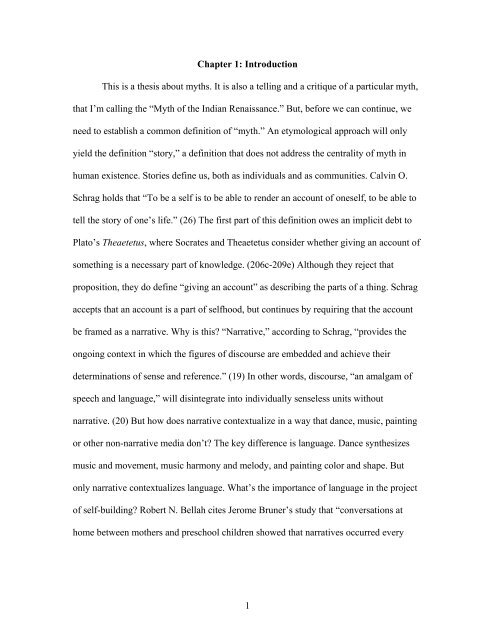The Intersection of Karuk Storytelling and Education
The Intersection of Karuk Storytelling and Education
The Intersection of Karuk Storytelling and Education
You also want an ePaper? Increase the reach of your titles
YUMPU automatically turns print PDFs into web optimized ePapers that Google loves.
Chapter 1: Introduction<br />
This is a thesis about myths. It is also a telling <strong>and</strong> a critique <strong>of</strong> a particular myth,<br />
that I’m calling the “Myth <strong>of</strong> the Indian Renaissance.” But, before we can continue, we<br />
need to establish a common definition <strong>of</strong> “myth.” An etymological approach will only<br />
yield the definition “story,” a definition that does not address the centrality <strong>of</strong> myth in<br />
human existence. Stories define us, both as individuals <strong>and</strong> as communities. Calvin O.<br />
Schrag holds that “To be a self is to be able to render an account <strong>of</strong> oneself, to be able to<br />
tell the story <strong>of</strong> one’s life.” (26) <strong>The</strong> first part <strong>of</strong> this definition owes an implicit debt to<br />
Plato’s <strong>The</strong>aetetus, where Socrates <strong>and</strong> <strong>The</strong>aetetus consider whether giving an account <strong>of</strong><br />
something is a necessary part <strong>of</strong> knowledge. (206c-209e) Although they reject that<br />
proposition, they do define “giving an account” as describing the parts <strong>of</strong> a thing. Schrag<br />
accepts that an account is a part <strong>of</strong> selfhood, but continues by requiring that the account<br />
be framed as a narrative. Why is this? “Narrative,” according to Schrag, “provides the<br />
ongoing context in which the figures <strong>of</strong> discourse are embedded <strong>and</strong> achieve their<br />
determinations <strong>of</strong> sense <strong>and</strong> reference.” (19) In other words, discourse, “an amalgam <strong>of</strong><br />
speech <strong>and</strong> language,” will disintegrate into individually senseless units without<br />
narrative. (20) But how does narrative contextualize in a way that dance, music, painting<br />
or other non-narrative media don’t? <strong>The</strong> key difference is language. Dance synthesizes<br />
music <strong>and</strong> movement, music harmony <strong>and</strong> melody, <strong>and</strong> painting color <strong>and</strong> shape. But<br />
only narrative contextualizes language. What’s the importance <strong>of</strong> language in the project<br />
<strong>of</strong> self-building? Robert N. Bellah cites Jerome Bruner’s study that “conversations at<br />
home between mothers <strong>and</strong> preschool children showed that narratives occurred every<br />
1
















